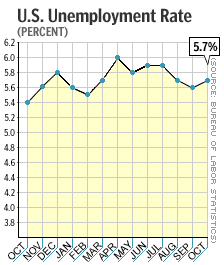NEW YORK (CNN/Money) - The U.S. unemployment rate rose in October and businesses cut more jobs from their payrolls, the government said Friday, as the labor market remained stagnant after nearly 1.8 million job cuts last year.
| 
| |

| 
| 
|

|
 CNNfn's economic correspondent Kathleen Hays takes a closer look at the jobs report. CNNfn's economic correspondent Kathleen Hays takes a closer look at the jobs report.
|
|
Play video
(QuickTime, Real or Windows Media)
|
| 
|

|
|
The Labor Department said unemployment rose to 5.7 percent in October from 5.6 percent in September. Employers cut 5,000 jobs from payrolls after cutting a revised 13,000 jobs in September.
Economists, on average, expected unemployment of 5.8 percent and flat payrolls, according to Briefing.com.
"This doesn't look like a significantly different report than we've gotten in past months, but that's significant in itself," Jared Bernstein, labor economist at the Economic Policy Institute, told CNNfn's CNNmoney Morning program. "The labor market is clearly stuck in neutral."

On Wall Street, stock prices turned higher at midday as investors focused on an expected interest rate cut by the Federal Reserve next week. But Treasury bond prices fell.
The reports have implications not only for next Wednesday's Fed meeting but also for Tuesday's election, in which Democrats hope to use recent economic weakness to hang on to the Senate and pry control of the House from Republicans.
At a Republican rally in Harrisburg, Pa., President Bush said October's drop in payrolls was a "problem," but said he thought the economy's foundations were strong.
In a separate report Friday, the Commerce Department said personal income rose 0.4 percent in September while personal spending fell 0.4 percent. Economists, on average, expected income to rise 0.5 percent and spending to fall 0.2 percent, according to Briefing.com.
Consumer spending is critical to the total economy's strength, since it makes up about two-thirds of total gross domestic product (GDP), the broadest measure of economic strength.
GDP grew at a 3.1 percent rate in the third quarter on the strength of consumer spending, which has been resilient despite a recession that began in March 2001, the Sept. 11 terrorist attacks, and numerous other worries.
The biggest threat to the continued strength of consumer spending is the labor market, which has been weak since March 2001, with nearly 1.8 million jobs being cut from non-farm payrolls.
Businesses have been unwilling to hire more workers because of concerns about the strength of the economy, a volatile stock market, the possibility of war in Iraq and other fears.
There were mixed messages in the unemployment report about how businesses are treating their labor force. The good news is that average hourly earnings rose 0.2 percent, or 3 cents, to $14.89. The bad news is that the average workweek shrank to 34.1 hours from 34.2 in September.
The service-producing sector, the biggest source of jobs in the economy, added 70,000 jobs in October; but the goods-producing sector, which has been in a prolonged slump since late 2000, cut 75,000 jobs.
In another measure of the manufacturing sector's health, the Institute for Supply Management said its index of national manufacturing activity dropped to 48.5 from 49.5 in September. Any reading below 50 indicates contraction in the sector.
And the Commerce Department said construction activity rose 0.6 percent in September to an annual rate of $836.7 billion, driven by a 1.6-percent jump in residential construction, as the red-hot housing market continued to be a bright spot for consumers.
Fed still likely to cut
Also helping to ease consumers' pain, the Fed cut its target for short-term interest rates 11 times in 2001. After keeping its key interest rate at a 40-year low throughout 2002, the central bank is widely expected to cut rates when it meets next week. Lower rates tend to boost the economy and corporate profits, thus lifting stock prices.
Though Friday's unemployment report was milder than some economists were expecting, it seems unlikely to change the Fed's mind about cutting rates, if in fact that's what it's inclined to do.
"Market expectations have priced a rate cut in," said Brown Brothers Harriman economist Lara Rhame, formerly an economist at the Fed. "When markets are pricing it in like that, the Fed can't afford to give a downside surprise in this environment."
Rhame also pointed to the jump in the personal savings rate in September, reported by the Commerce Department Friday, to 4.2 percent from 3.4 percent. Combined with a dramatic plunge in one measure of consumer confidence in October, it looks like the consumer will need some encouragement before the critical holiday shopping season.
"The consumer is the last support here, and it's not getting any help," Rhame said. "The savings rate plus the confidence plunge add up to enough reasons for the Fed to give consumers a psychological boost."

|

